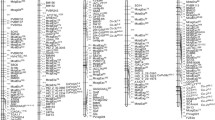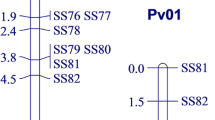Abstract
Anthracnose is a serious disease affecting dry bean production especially in the cool highland areas worldwide. The objective of this research was to study the inheritance of anthracnose resistance in market-class dry beans. A complete diallel set of crosses was generated from nine diverse parents comprising six resistant and three susceptible to anthracnose. The F1 and F2 crosses and parents were artificially inoculated with Colletotriclum lindenumthianum Race-767 in a growth room. There was significant variation for anthracnose resistance among genotypes. General combining ability (GCA) and specific combining ability effects were significant for resistance, indicating importance of both additive and non-additive effects, respectively. Preponderance of GCA effects (66%) suggested that additive effects were more important than non-additive effects (24%), which were also reflected by high heritability estimates (70%), and suggested that simple selection or backcrossing would be useful for improving the resistance in market class varieties. The study was not conclusive on whether epistatic gene action played a major role, but if available it might have biased the dominance gene effects. Reciprocal effects (10%) were not significant (P > 0.05), suggesting that cytoplasmic genes did not play a major role in modifying anthracnose resistance. Parental lines G2333, AB136, NAT002, and NAT003 showed highly negative GCA effects qualifying them as suitable parents for transferring resistance genes to their progenies. A few major genes, 1–3, displaying partial dominance conditioned anthracnose resistance, suggesting a possibility of using marker-assisted selection to improve anthracnose resistance in market-class dry beans.

Similar content being viewed by others
References
Alzate-Marin AL, Baia GS, de Paula Junior TJ, de Carvalho GA, de Barros EG, Moreira MA (1997) Inheritance of anthracnose resistance in common bean differential cultivar AB 136. Plant Dis 81:996–998. doi:10.1094/PDIS.1997.81.9.996
Bjarko ME, Line RF (1988) Heritability and number of genes controlling leaf rust resistance. Phytopathology 78:4157–4161
Champion MR, Brunet D, Maudit ML, Ilami R (1973) Methode de controle de la resistance desvarietes de haricots a l’antracnose (Colletotrichum lindemuthianum (Sacc & Magn.) Briosi et Cav. C. R. Hebd. Seances Acad Agric Fr 59:951–958. English Abstract
Christie BR, Shattuck VI (1992) The diallel cross: design, analysis and use for plant breeders. Plant Breed Rev 9:9–36
Christie BR, Shattuck VI, Dick JA (1988) The diallel cross: its analysis and interpretation. Department of Horticulture, University of Guelph, Ontario
Dabholkar RR (1992) Elements of biometrical genetics. Ashok Kumar Mittal Concept Publishing Company, New Delhi
David S, Kasozi S, Wortmann C (1997) An investigation of alternative bean seed marketing channels in Uganda. Network on Bean Research in Africa, Occasional Publications Series, No. 19. CIAT, Kampala, Uganda
FAO (2003) Food and agriculture organisation quarterly bulletin of statistics. FQBS 12:49
Garzon LN, Ligarreto GA, Blair MW (2008) Molecular marker-assisted backcrossing of anthracnose resistance into Andean climbing beans (Phaseolus vulgaris L.). Crop Sci 48:562–570. doi:10.2135/cropsci2007.08.0462
Goncalves-Vidigal MC, Cardoso AA, Viera C, Saraiva LS (1997) Inheritance of anthracnose resistance in common bean genotypes P. I. 207262 and AB 136. Braz. J. Genet 20:59–62
Graham PH, Ranalli P (1997) Common bean (Phaseoulus vulgaris L.). Field Crops Res 53:131–146. doi:10.1016/S0378-4290(97)00112-3
Griffing B (1956) Concept of general and specific combining ability in relation to diallel crossing systems. Aust J Biol Sci 9:4163–4193
Hayman BI (1954) Theory and analysis of diallel crosses. Genetics 39:789–808
Kearsey MJ, Pooni S (1996) The genetic analysis of quantitative traits. Chapman and Hall, London
Kelly JD, Vallejo VA (2004) A comprehensive review of the major genes conditioning resistance to anthracnose in common bean. HortScience 39:1196–1207
Leakey CLA (1970) The improvement of bens (Phaseolus vulgaris) in East Africa. In: Leakey CLA (ed) Crop improvement in East Africa. The Commonwealth Agricultural Bureaux, London, pp 98–128
Mather K, Jinks J (1982) Biometrical genetics. Chapman and Hall, London
Miklas PN, Kelly JD (2002) The use of MAS to develop pinto bean germplasm possessing Co42 gene for anthracnose resistance. Annu Rep Bean Improv Coop 45:68–69
Miklas PN, Kelly JD, Beebe SE, Blair MW (2006) Common bean breeding for reistance against biotic and abiotic stresses: from classical to MAS breeding. Euphytica 147:105–131. doi:10.1007/s10681-006-4600-5
Nkalubo S (2006) Study of anthracnose (Colletotrichum lindemuthianum) resistance and its inheritance in Ugandan dry bean germplasm. Unpublished PhD thesis, University of KwaZulu-Natal, South Africa
Nkalubo S, Melis R, Laing MD, Opio F (2007) Yield loss associated with anthracnose disease on Ugandan market-class dry bean cultivars. Afr Crop Sci Conf Proc 8:869–874. El-Minia, Egypt
Opio F, Ugen MA, Kyamanywa S, David S, Mugisha-mutetikka M (2001) Beans. In: Mukiibi JK, Esete JP, Musoli PC, Oryokot JOE, Twinamasiko E, Odongkan OK, Esegu JFO, Otim-Nape GW, Ssali H, Odogola W (eds) Agriculture in Uganda. volume II crops. NARO, Kampala
Pastor-Corrales M, Tu JC (1989) Anthracnose. In: Schwartz HF, Pastor-Corrales MA (eds) Bean production problems in the tropics. Centro Intemacional de Agricultura Tropical (CIAT), Cali, pp 77–93
Payne RW, Murray DA, Harding SA, Baird DB, Soutar DM (2007) GenStat for windows (10th edn) introduction. VSN International, Hemel
Singh SP, Pastor-Corrales M, Molina A, Otoya M (1992) Breeding common bean for resistance to anthracnose. In: La Antracnosis del Frijol Común, Phaseolus vulgaris, en América Latina. Doc, de trabajo, pp 198–211
Vogel KP, Haskins FA, Gorz HJ (1980) Parent progeny regression in indiangrass: inflation of heritability estimates by environment covariances. Crop Sci 20:580–582
Xu Y, Crouch JH (2008) Marker-assisted selection in plant breeding: from publications to practice. Crop Sci 48:391–407. doi:10.2135/cropsci2007.04.0191
Young R, Kelly JD (1996) Characterisation of the genetic resistance to Colletotrichum lindemuthianum in common bean differential cultivars. Plant Dis 80:650–654
Author information
Authors and Affiliations
Corresponding author
Rights and permissions
About this article
Cite this article
Nkalubo, S.T., Melis, R., Derera, J. et al. Genetic analysis of anthracnose resistance in common bean breeding source germplasm. Euphytica 167, 303–312 (2009). https://doi.org/10.1007/s10681-008-9873-4
Received:
Accepted:
Published:
Issue Date:
DOI: https://doi.org/10.1007/s10681-008-9873-4




